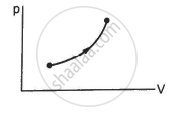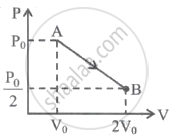Advertisements
Advertisements
Question
A gas in equilibrium has uniform density and pressure throughout its volume. This is strictly true only if there are no external influences. A gas column under gravity, for example, does not have the uniform density (and pressure). As you might expect, its density decreases with height. The precise dependence is given by the so-called law of atmospheres
n2 = n1 exp [-mg (h2 – h1)/ kBT]
Where n2, n1 refer to number density at heights h2 and h1 respectively. Use this relation to derive the equation for sedimentation equilibrium of a suspension in a liquid column:
n2 = n1 exp [-mg NA(ρ - P′) (h2 –h1)/ (ρRT)]
Where ρ is the density of the suspended particle, and ρ’ that of surrounding medium. [NA is Avogadro’s number, and R the universal gas constant.] [Hint: Use Archimedes principle to find the apparent weight of the suspended particle.]
Solution 1
According to the law of atmospheres, we have:
n2 = n1 exp [-mg (h2 – h1)/ kBT] … (i)
Where,
n1 is the number density at height h1, and n2 is the number density at height h2
mg is the weight of the particle suspended in the gas column
Density of the medium = ρ'
Density of the suspended particle = ρ
Mass of one suspended particle = m'
Mass of the medium displaced = m
Volume of a suspended particle = V
According to Archimedes’ principle for a particle suspended in a liquid column, the effective weight of the suspended particle is given as:
Weight of the medium displaced – Weight of the suspended particle
= mg – m'g
`= mg - V rho'g = mg - (m/rho)rho'g`
`= mg (1-(rho')/rho)` ...(ii)
Gas constant, R = kBN
`k_B = R/N` ....(iii)
Substituting equation (ii) in place of mg in equation (i) and then using equation (iii), we get:
n2 = n1 exp [-mg (h2 – h1)/ kBT]
`= n_1 exp[(-mg(h_2 - h_1))/ (k_BT)]`
`= n_1 exp [-mg(rho - rho')(h_2 - h_1) N/(RTrho)]`
Solution 2
Considering the particles and molecules to be spherical, the weight of the particle is
`W = mg = 4/3 pir^3rhog` ... (i)
Where r = radius of the particle and rho = density of the particle. Its motion under gravity causes buoyant force to act upward which is equal to
B= Volume of particle x density of the surrounding medium x g
`= 4/3 pir^3rho'g`
if F be the downward force acting on the particle then
`F = W - B = 4/3 pir^3(rho -rho')g` .....(iii)
Also `n_2 = n_1 exp[(-mg)/k_BT(h_2-h_1)]` .... (iv)
Where `k_B` - boltzman constant
`n_1` and `n_2` are number densities at height `h_1` and `h_2` respectvely. Here mg can be replaced by effective force F given by the equation (iii)
:. From iii and iv we get
`n_2 = n_1 exp [-(4pi)/3 r^3 ((rho -rho'))/(k_BT) g(h_2 - h_1)]`
`= n_1 exp [-(4pi)/3 r^3 (rhog(1-(rho')/rho)(h_2-h_1))/((RT)/N_A)]` [∵ `K_B = R/N_A`]
`n_2= n_1 exp [- (mg N_A(1-(rho')/rho)(h_2-h_1))/(RT)]`
which is required relation where `4/3 pir^3 rhog` = mass of the particle x g = mg
APPEARS IN
RELATED QUESTIONS
An air bubble of volume 1.0 cm3 rises from the bottom of a lake 40 m deep at a temperature of 12 °C. To what volume does it grow when it reaches the surface, which is at a temperature of 35 °C?
An electric bulb of volume 250 cc was sealed during manufacturing at a pressure of 10−3 mm of mercury at 27°C. Compute the number of air molecules contained in the bulb. Avogadro constant = 6 × 1023 mol−1, density of mercury = 13600 kg m−3 and g = 10 m s−2.
Use R=8.314J K-1 mol-1
Consider a sample of oxygen at 300 K. Find the average time taken by a molecule to travel a distance equal to the diameter of the earth.
Use R=8.314 JK-1 mol-1
Find the ratio of the mean speed of hydrogen molecules to the mean speed of nitrogen molecules in a sample containing a mixture of the two gases.
Use R = 8.314 JK-1 mol-1
Figure shows a vessel partitioned by a fixed diathermic separator. Different ideal gases are filled in the two parts. The rms speed of the molecules in the left part equals the mean speed of the molecules in the right part. Calculate the ratio of the mass of a molecule in the left part to the mass of a molecule in the right part.

Estimate the number of collisions per second suffered by a molecule in a sample of hydrogen at STP. The mean free path (average distance covered by a molecule between successive collisions) = 1.38 × 10−5 cm.
Use R = 8.31 JK−1 mol−1
Hydrogen gas is contained in a closed vessel at 1 atm (100 kPa) and 300 K. (a) Calculate the mean speed of the molecules. (b) Suppose the molecules strike the wall with this speed making an average angle of 45° with it. How many molecules strike each square metre of the wall per second?
Use R = 8.31 JK-1 mol-1
The ratio Cp / Cv for a gas is 1.29. What is the degree of freedom of the molecules of this gas?
The figure shows a process on a gas in which pressure and volume both change. The molar heat capacity for this process is C.

One mole of gas expands obeying the relation as shown in the P-V diagram. The maximum temperature in this process is equal to ______.

